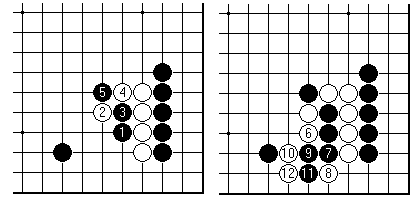

Everyone likes to attack. The reputation of 'Killer' Kato Masao, who dominated go in Japan for a while two decades ago with a winning percentage of over 70 per cent, casts a long shadow with amateurs. The more prosaic truth is that he reached the height of his powers by giving up going for the kill, and has now joined other baby-boomers who have become icons of orthodoxy.
The problem with attacking for the sake of it is the one Napoleon found in Russia. In attempting a knock-out punch you may become over-extended. Subsequent defence of your own forces is then technically tough and bad for morale.

This kind of immediate, liberty-filling attack can be ruled out of consideration very quickly. Not only does Black's attack fail. That must be expected if stones are placed too close, where they are already short of liberties. But the attacking player will be marked down for a lack of subtlety. As they say, you probably also prefer the Three Stooges to the Marx Brothers.
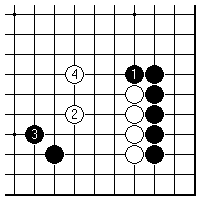
The correct way for Black to attack in this position will be more like this diagram. Black's plays 1 and 3 are useful in themselves. White moves out into the centre of the board. Since the white group doesn't yet have two obvious eyes Black can expect further attacking plays, perhaps a little later in the game. Some immediate gain is apparent - a play to consolidate on the lower side, developing from 3, is probably now in order.
As we look round the club at players' games you comment that much of the manoeuvring isn't comprehensible. Well, Go is a complex game, but the complexity isn't fed into the game with the rules. It arises from the highly stratified nature both of tactics and of strategy. Perhaps there is a useful comparison with oil painting. The total picture comes from a background that is quite plain overlaid by many layers, each of which is seemingly transparent if you are able to isolate its effect.
Assuming that's a good working model, let's kibitz a game where one of the players has yet to grasp a key concept on attack.
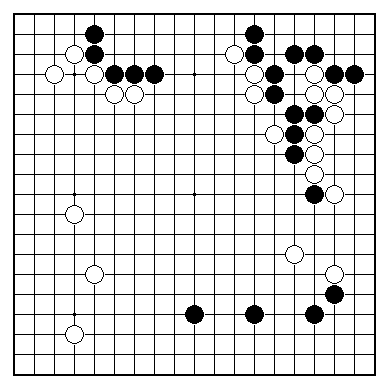
This is the position with Black (TODD, graded 14 kyu) to play against ALABAMA (13 kyu - the handicap for one grade difference is to play without komi). Here Black has built a good position in the upper right by slicing though White, leaving four white stones beleagured up against the black wall.
Black should launch an attack against these stones - but how, exactly?
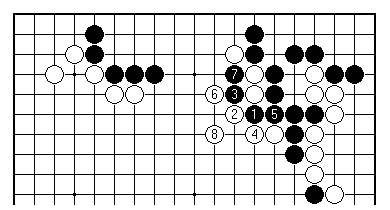
This is the sequence of the next few plays from the game. At the end of it Black has blown the opportunity of a major attack. Black has captured two stones, true; and can expect to pick up one more. But White has limited the damage (Black made this easier by playing 5 where it is, rather than the capture at 7).
TODD seems to be missing the idea of attacking on a grand scale.
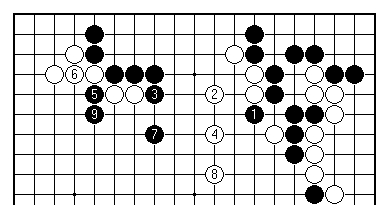
In search of a better way to play let's keep Black 1, which is locally a key point. This may look a reasonable continuation to a player around 4 kyu. Black 3 is powerful. While White runs out into the centre, Black takes profit on the other side with 5 and 9. There is a chance of further attack against the white top left corner and centre, so this seems superior.
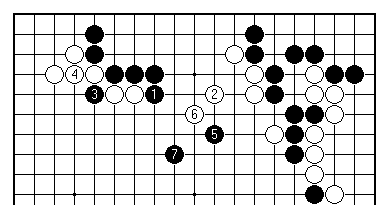
Moving up another few notches, this attacking sequence is more like dan play. There are certainly far too many possible variations to examine, if you want a firm conclusion. But here are the highlights:
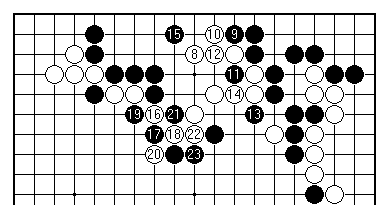
This is one possible development, in which White looks to make eye space on the top side. Since White ends up only with one eye, a break-out attempt into the centre is also required. Here we can leave the position and these hypotheticals. It may be that the white group will live, but Black is able to pick up enough compensating gains round the fringes of the fight - some are already apparent.
Would this sort of analysis convince TODD? Experience tells us "no". How do you put across something that is a knack? Learning Go has something in common with riding a bicycle, too. You can't usefully instruct anyone "keep your balance". At the level of pointing out that steering is more about leaning to shift your centre of gravity slightly than forcing the handlebars round, a teacher can help. There isn't anything particularly "oriental" about saying this; which doesn't always stop the pupils taking a light touch approach for studied vagueness.
First published 30 March 2000 as On Your Side on MindZine,
Go Learning
© Charles Matthews 2000.